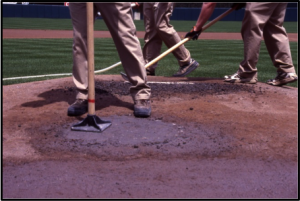One of the most important things any grounds crew can do throughout the season is maintain a groundskeeper checklist. This is where you would document all of the successes, difficulties, or issues you encounter. These checklists allow you and/or your successors to avoid repeating the same mistakes so you can make better decisions and instead enjoy more repeatable successes.
► Surprise!
One of my biggest pet peeves as a stadium assistant was when we would have an issue with an on-field event that had also occurred the season before I had arrived — like, “WHAT?! You’re telling me the fireworks show last year damaged the left field turf? Why did that happen? Did we ask the pyrotechnics to move their location? Did anyone tell the front office?” Having the ability to document all events — good, bad and ugly — is critical.
► Tracking Costs
In an earlier post, “The Real Cost of Sports Field Maintenance Products“, Paul Zwaska shared how using the most expensive professional-grade clay on their Little League fields actually kept the pitcher’s mound and batter’s box in much better shape, and with less costs. The better grade clay reduced the damage to the clay areas by 70%. By the end of the season, they found they had used 50% less clay. By having documented what the fields used year-to-year, the grounds crew was able to discover that using the most expensive product actually a sound financial decision – AND the high-grade clay provided a better playing surface for the players.
► Creating A Groundskeeper Checklist
A groundskeeper checklist can save you time, headaches, stress – and money. Start getting organized now when you have some downtime. First, decide what you’re going to track. Secondly, decide how you are going to track — Paper? Shared Dropbox folder? Third, make sure you communicate with the rest of your staff and volunteers how they can keep this information up-to-date. Some vital information most baseball and softball fields track include:
- Log of employee hours
- Days you were short staffed and how it affected the field
- Budgeting expenses
- Performance and maintenance of tools and machines
- Special events and how they impacted the fields
- Weather conditions and how they impacted the fields and budget.
- Field opening / field closing routines
Gathering some information is better than not having any information at all.
What information do you track? Do you use spreadsheets? A clipboard in the equipment shed? We’d love to hear your best practices – either share in the comments below or send an email to info@beaconathletics.com.
